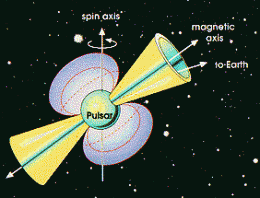January 14, 2010 report
Radio pulses from pulsar appear to move faster than light

(PhysOrg.com) -- Laboratory experiments in the last few decades have shown that some things can appear to move faster than light without contradicting Einstein's special theory of relativity, but now astrophysicists have seen real examples of superluminal speeds in the form of radio pulses from a pulsar.
Superluminal, or faster than light, speeds are associated with anomalous dispersion, which is a process in which the refractive index of a medium increases with the wavelength of light passing through it. If a light pulse (consisting of a group of light waves at different wavelengths) passes through such a medium, the group velocity of the pulse can increase to a velocity greater than any of the waves within the pulse, but the energy of the pulse still travels at the speed of light, which means information is transmitted in accordance with Einstein's theory.
Astrophysicists, led by Frederick Jenet of the University of Texas at Brownsville, have been monitoring a pulsar, PSR B1937+21, which is about 10,000 light years from Earth. They used the Arecibo Observatory in Puerto Rico to obtain radio data over three days at 1420.4 MHz with a bandwidth of 1.5 MHz. They found that pulses closer to the center arrived earlier than the normal timing, which suggests they had travelled faster than the speed of light.
A pulsar is a neutron star that is spinning rapidly and emitting a rotating beam of radio radiation as it spins, which is observed on Earth at regular intervals rather like light from a lighthouse. The pulses of radiation can be affected by several factors as they travel through the interstellar medium (ISM). Their polarization can be rotated if they pass through a magnetic field, for example, and they can be scattered if they encounter free electrons, and can be absorbed by neutral hydrogen in the ISM. Jenet and his colleagues think anomalous dispersion also affects the pulses.
According to Jenet and colleagues, the pulses from the pulsar traveled through a cloud of neutral hydrogen, which has a resonance of 1420.4 MHz -- the exact center of the bandwidth studied. Passing through the cloud caused anomalous dispersion that resulted in a superluminal group velocity, and pulses with frequencies closest to the resonance frequency arrived earlier than other pulses.
The scientists believe the pulses appear to travel faster than light because of an "interplay between the time scales present in the pulse and the time scales present in the medium." The faster-than-light pulses do not violate Einstein's theory because technically the pulse carries no information. The effect has been known in laboratory experiments, but these observations were the first in an astrophysical context.
The findings, to be published in the Astrophysical Journal, could help astronomers gain a more complete understanding of the composition of space in the regions between stars, and in particular the properties of neutral hydrogen clouds in our galaxy.
More information: A preprint of the article is available at arxiv.org/abs/0909.2445v2 .
© 2010 PhysOrg.com

















